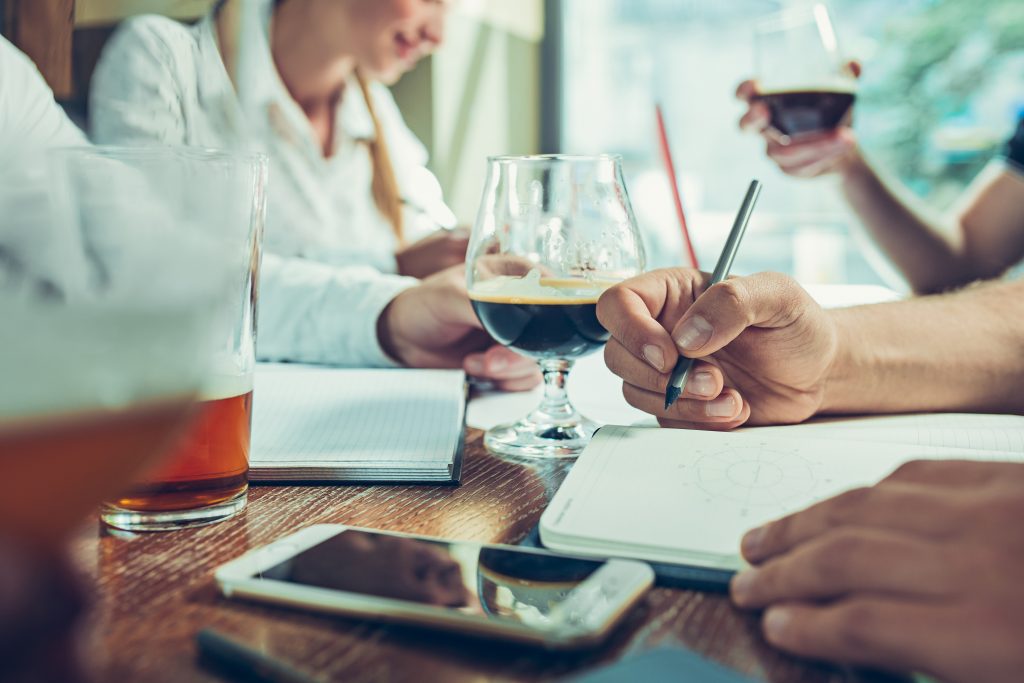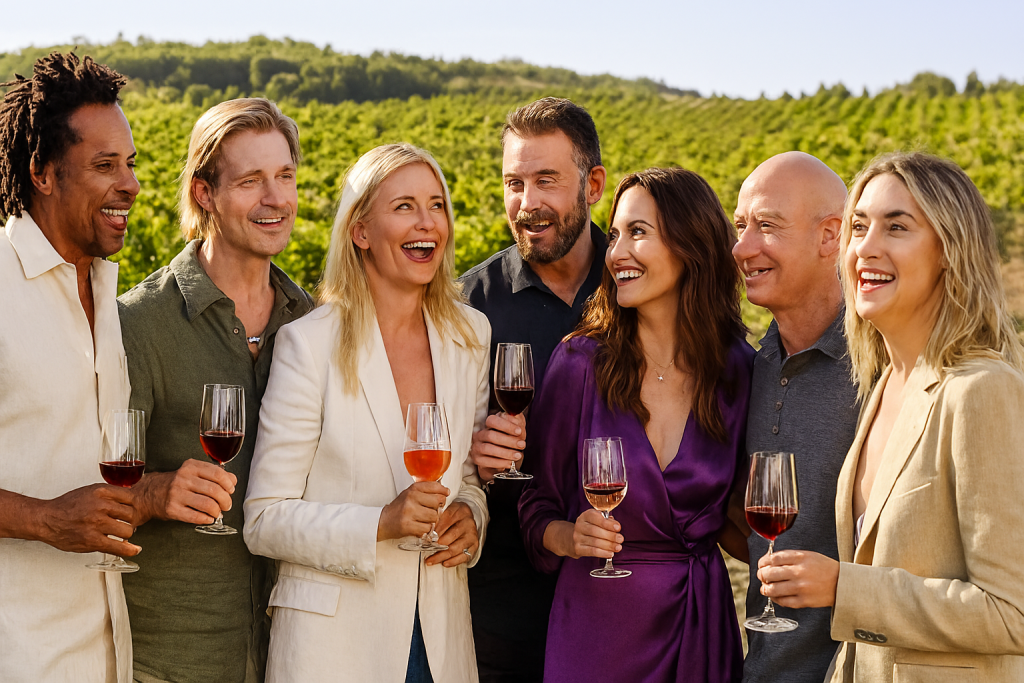Looking to enhance your tasting skills and deepen your knowledge of the world of wine? Look no further! In this article, we’ll explore the top courses in wine tasting perfect for enthusiasts like you. Whether you’re a beginner eager to learn the basics or a seasoned connoisseur seeking to refine your palate, these courses offer a wealth of information and hands-on experience. Led by master sommeliers or renowned wine educators, you’ll find online video courses and in-person tastings tailored to your learning style and schedule. Delve into the intricacies of wine production, learn the art of blind tasting, and discover how to expertly pair food and wine. Gain the skills and confidence to navigate the world of wine with ease. Let’s embark on a flavorful journey together!
Contents
- Wine Tasting Essentials
- Sensory Evaluation Techniques
- Old World Vs. New World Wines
- Exploring Different Grape Varieties
- The Art of Blind Tasting
- Food and Wine Pairing Mastery
- Understanding Wine Regions and Terroir
- Sparkling Wines: From Champagne to Prosecco
- Wine and Cheese Pairing
- Wine Cellar Management and Aging
Wine Tasting Essentials
To enhance your wine tasting skills, it is essential to develop a strong foundation in understanding the nuances of different wines through hands-on experience. One of the first steps in building this foundation is mastering sensory evaluation techniques. By honing your ability to analyze the appearance, aroma, and taste of a wine, you can discern the subtle characteristics that make each wine unique.
Another crucial aspect of wine tasting is exploring different grape varieties. Each grape variety brings its own flavor profile and characteristics to the wine, and understanding these differences is key to becoming a knowledgeable wine taster. By tasting wines made from various grape varieties, such as Chardonnay, Cabernet Sauvignon, or Pinot Noir, you can develop a palate that can identify and appreciate the distinct qualities of each wine.
Food and wine pairing mastery is another important skill to acquire in your wine tasting journey. Knowing which wines complement specific dishes can enhance the overall dining experience. Whether it’s a robust red wine with a juicy steak or a crisp white wine with a delicate seafood dish, understanding the principles of food and wine pairing can elevate your enjoyment of both.
In addition to food, wine and cheese pairing is a classic combination worth exploring. The complex flavors and textures of different cheeses can be beautifully complemented by the right wine. From creamy brie paired with a sparkling wine to a bold blue cheese accompanied by a rich red wine, the possibilities are endless.
Furthermore, understanding wine cellar management and aging is crucial for wine enthusiasts. Properly storing and aging wines can enhance their flavors and aromas over time. Learning about the ideal conditions for cellaring wine, such as temperature and humidity control, can help you preserve and appreciate your collection.
Sensory Evaluation Techniques
Develop your wine tasting skills by mastering sensory evaluation techniques. These techniques are essential for developing your palate and honing your ability to discern the nuances of different wines. By understanding sensory evaluation techniques, you can identify wine faults and flaws, analyze the structure of a wine, and identify the unique aroma profiles that make each wine distinct.
When it comes to developing your palate, sensory evaluation techniques are crucial. They allow you to train your senses to detect the subtle flavors and characteristics of different wines. By practicing these techniques, you can become more adept at identifying the specific flavors and aromas in a wine, such as fruity notes or earthy undertones.
In addition to flavor detection, sensory evaluation techniques also help you analyze the structure of a wine. This includes assessing the acidity, tannins, and body of the wine. By understanding the structure of a wine, you can gain insights into its quality and potential for aging.
Another important aspect of sensory evaluation is identifying aroma profiles. This involves recognizing the various scents and aromas present in a wine, such as floral, herbal, or oaky notes. By developing your ability to identify and describe these aromas, you can better appreciate the complexity and depth of a wine.
Mastering sensory evaluation techniques allows you to taste wine like a pro. It enables you to confidently assess a wine’s quality, identify its unique characteristics, and appreciate the artistry and craftsmanship behind each bottle. So, why not take the time to learn and practice these techniques? Your wine tasting experience will undoubtedly be elevated to new heights.
Old World Vs. New World Wines
If you’re a wine lover, you may be curious about the differences between Old World and New World wines. Each style has its own unique characteristics shaped by various factors, including winemaking techniques, climate, tradition, and technology. Old World winemaking, rooted in centuries of tradition, focuses on terroir and the expression of a specific region. These wines often exhibit elegance, complexity, and a sense of place. Old World winemakers rely on traditional methods, such as hand harvesting and fermentation in oak barrels, to create wines that reflect the unique qualities of their vineyards.
On the other hand, New World wines have emerged in regions outside of Europe, such as the United States, Australia, and South America. These regions have different climates and soil types, which influence the style and flavor profiles of the wines. New World winemakers embrace modern winemaking techniques and technology to produce wines that are fruit-forward, bold, and approachable. They often use stainless steel tanks for fermentation and employ techniques like cold soaking and micro-oxygenation to enhance flavors and textures.
The impact of climate cannot be underestimated when comparing Old World and New World wines. Old World regions often have cooler climates, resulting in wines with higher acidity, lower alcohol levels, and more pronounced minerality. In contrast, New World regions tend to have warmer climates, leading to riper fruit flavors, higher alcohol levels, and softer tannins.
While tradition plays a significant role in Old World winemaking, the emergence of new world wine regions has allowed for experimentation and innovation. New World winemakers have the freedom to explore different grape varieties and winemaking techniques, resulting in a diverse range of styles and flavors.
Technology also plays a vital role in New World winemaking. From vineyard management systems to temperature-controlled fermentation tanks, technology enables winemakers to have precise control over the winemaking process, resulting in consistent and high-quality wines.
Exploring Different Grape Varieties
As a wine lover, you can expand your knowledge and palate by exploring different grape varieties through various wine tasting courses. Exploring grape varieties allows you to delve into the world of emerging varietals, indigenous grapes, lesser-known cultivars, unusual blends, and classic varietal comparisons. By understanding the unique characteristics of each grape variety, you can develop a deeper appreciation for the diverse flavors, aromas, and styles of wines.
To illustrate the breadth and depth of grape varieties, let’s take a closer look at some examples:
| Grape Varieties | Description |
|---|---|
| Emerging varietals | These are grape varieties that are gaining popularity in the wine world. They often come from lesser-known regions and offer unique flavor profiles. Examples include Albariño from Spain and Grüner Veltliner from Austria. |
| Indigenous grapes | These are grape varieties that are native to a specific region or country. They are deeply rooted in the local winemaking traditions and showcase the terroir. Examples include Sangiovese from Italy and Malbec from Argentina. |
| Lesser-known cultivars | These are grape varieties that may not be as widely recognized but still offer exceptional wines. They provide an opportunity to discover hidden gems and expand your wine repertoire. Examples include Vermentino from Italy and Tannat from Uruguay. |
| Unusual blends | These are wines made from a combination of different grape varieties, creating unique flavor profiles and complexities. Examples include GSM blends (Grenache, Syrah, Mourvèdre) from the Rhône Valley and Bordeaux blends (Cabernet Sauvignon, Merlot, Cabernet Franc) from Bordeaux. |
| Classic varietal comparisons | These are tastings that compare wines made from the same grape variety but from different regions or winemaking styles. They allow you to explore the nuances and variations within a single grape variety. Examples include comparing Chardonnay from Burgundy and California or Pinot Noir from Oregon and New Zealand. |
Exploring different grape varieties is a fascinating journey that can deepen your understanding of wine and enhance your tasting experiences. Whether you’re drawn to emerging varietals, indigenous grapes, lesser-known cultivars, unusual blends, or classic varietal comparisons, there are wine tasting courses available that can guide you on this exciting exploration. So, grab your wine glass and embark on a delightful adventure through the world of grape varieties.
The Art of Blind Tasting
Enhance your wine tasting skills by mastering the art of blind tasting. Blind tasting techniques are essential for developing a refined palate and honing your ability to discern the characteristics of different wines without visual cues. However, blind tasting poses its own set of challenges. Without knowing the varietal, region, or producer, you must rely solely on your senses to identify the wine’s aromas, flavors, and structure.
To excel in blind tasting, consistent practice is key. Blind tasting exercises can include tasting flights of different wines and trying to identify their varietals, regions, or vintages. Start by focusing on the basics, such as identifying the wine’s color, clarity, and intensity. Then move on to the aroma, paying attention to the wine’s fruit, floral, and earthy notes. When it comes to taste, consider the wine’s acidity, tannins, and body.
Blind tasting tips can help you navigate through the process. Take your time to observe and analyze the wine before jumping to conclusions. Use a systematic approach, such as the deductive method, to narrow down the possibilities. Practice memorizing classic flavor profiles and familiarize yourself with different grape varieties and wine regions. Finally, trust your instincts and have confidence in your abilities.
Food and Wine Pairing Mastery
Master the art of pairing food and wine with precision and confidence through immersive courses and workshops. Enhance your culinary experiences by learning the secrets of successful food and wine pairing. Here are three essential aspects to consider when exploring the world of food and wine pairing:
- Food and Wine Pairing Suggestions: Discover the perfect harmony between flavors and textures by exploring expert-recommended food and wine pairings. Unleash your creativity by experimenting with classic combinations like red wine with steak or white wine with seafood. Expand your repertoire by exploring unconventional pairings like sparkling wine with fried chicken or rosé with spicy Asian cuisine.
- Wine Tasting Techniques: Develop your palate and refine your wine tasting skills to better appreciate the nuances of different varietals. Learn how to identify the key characteristics of wines such as acidity, tannins, and sweetness. This knowledge will enable you to make informed decisions when pairing wines with specific dishes.
- Wine and Chocolate Pairing, Wine and Seafood Pairing, Wine and Vegetarian Dishes: Delve into the world of specialized food and wine pairings. Discover the complexities of pairing wine with chocolate, understanding how different types of chocolate interact with various wine varietals. Dive into the realm of seafood pairing, exploring the interplay between delicate flavors and the briny notes of seafood. Lastly, explore the versatility of wine when paired with vegetarian dishes, uncovering the perfect match for plant-based meals.
Understanding Wine Regions and Terroir
Explore the diverse wine regions and unique terroirs that contribute to the complex flavors and characteristics found in wines. Understanding wine regions and terroir is essential for any wine lover who wants to truly appreciate and grasp the intricacies of their favorite beverage.
Soil composition plays a critical role in shaping the flavor profile of wines. Different types of soil, such as limestone, clay, or gravel, can impart distinct qualities to the grapes, resulting in wines with varying levels of minerality, acidity, and depth. Climate and terroir also have a profound impact on the final product. The relationship between climate and terroir is a fascinating exploration of how environmental factors, such as temperature, rainfall, and sunlight, interact with the soil and topography to create unique growing conditions for vines.
Each wine region has its own set of characteristics that make it special. From the lush valleys of Napa Valley to the rugged hills of Tuscany, each region offers a unique combination of climate, soil, and grape varieties that contribute to the distinctiveness of its wines. Altitude also plays a role in wine production, as higher elevations can influence temperature and sunlight exposure, resulting in wines with more complexity and elegance.
Vineyard management practices are another crucial factor in terroir expression. From pruning techniques to irrigation methods, every decision made in the vineyard can have a direct impact on the quality and character of the wine. Skilled vineyard managers understand the importance of nurturing the vines and creating an optimal environment for them to thrive.
Sparkling Wines: From Champagne to Prosecco
If you’re a wine lover looking to expand your knowledge and appreciation of sparkling wines, there are several top courses available that can help you deepen your understanding of these effervescent delights. Here are three key areas that these courses cover:
- Champagne trends: Learn about the latest developments in the world of Champagne, from new production techniques to emerging trends in flavor profiles. Discover the different styles of Champagne, such as Brut, Extra Brut, and Demi-Sec, and learn how to identify the nuances and characteristics that make each one unique.
- Prosecco production: Delve into the world of Prosecco, the refreshing Italian sparkling wine that has gained popularity in recent years. Explore the production methods used in the Prosecco region, including the Charmat method, which gives Prosecco its distinctive effervescence. Gain insights into the different classifications of Prosecco, such as Prosecco Superiore and Prosecco DOCG, and learn how to appreciate the vibrant flavors and aromas of this beloved bubbly.
- Sparkling wine regions: Take a virtual journey around the globe to explore the diverse sparkling wine regions. From the renowned Champagne region in France to the lesser-known sparkling wine regions of Spain, Italy, and the New World, discover the unique terroirs and grape varietals that contribute to the production of these sparkling gems. Expand your palate by tasting sparkling wines from different regions and learn how to identify the regional characteristics that define each one.
Wine and Cheese Pairing
When pairing wine and cheese, it’s important to consider the complementary flavors and textures that can enhance your tasting experience. Different types of cheese can bring out different characteristics in wine, creating a harmonious and enjoyable combination. To help you navigate the world of wine and cheese pairing, here are some suggestions to elevate your taste buds:
| Wine Pairing | Cheese Pairing |
|---|---|
| Wine and Cheese Pairing | Soft and creamy cheeses like Brie or Camembert pair well with sparkling wines like Champagne or Prosecco. The effervescence of the wine cuts through the richness of the cheese, cleansing the palate. For a more robust cheese, such as Cheddar or Gouda, opt for a medium-bodied red wine like Cabernet Sauvignon or Merlot. The tannins in the wine can complement the bold flavors of the cheese. |
| Wine and Chocolate Pairing | Wine and chocolate pairing is a match made in heaven. Try pairing dark chocolate with a full-bodied red wine like Malbec or Zinfandel. The rich and complex flavors of the chocolate are beautifully enhanced by the fruity and velvety notes of the wine. For milk chocolate, opt for a sweeter wine like Port or a Late Harvest Riesling. The sweetness of the wine complements the creamy and smooth texture of the chocolate. |
| Wine and Charcuterie Pairing | When it comes to pairing wine with charcuterie, it’s all about balance. The saltiness and richness of cured meats like prosciutto or salami can be complemented by a dry and crisp white wine like Sauvignon Blanc or a rosé. The acidity of the wine cuts through the fat of the meat, creating a harmonious combination. For spicier cured meats like chorizo or pepperoni, opt for a medium-bodied red wine like Syrah or Tempranillo. The bold flavors of the meat are enhanced by the fruity and spicy notes of the wine. |
| Wine and Seafood Pairing | When pairing wine with seafood, it’s important to consider the delicacy of the flavors. Light-bodied white wines like Chardonnay or Sauvignon Blanc are great choices for delicate seafood like oysters or grilled fish. The crisp and citrusy notes of the wine complement the freshness of the seafood. For richer seafood like lobster or scallops, opt for a medium-bodied white wine like Viognier or a light-bodied red wine like Pinot Noir. The floral and fruity flavors of the wine enhance the richness of the seafood. |
| Wine and Vegetarian Dishes Pairing | Vegetarian dishes can be versatile in terms of wine pairing. For lighter vegetarian dishes like salads or roasted vegetables, opt for a light-bodied white wine like Pinot Grigio or a dry rosé. The fresh and vibrant flavors of the wine complement the lightness of the dish. For heartier vegetarian dishes like pasta with tomato sauce or mushroom risotto, opt for a medium-bodied red wine like Sangiovese or a fruity red blend. The acidity and tannins of the wine complement the richness of the dish. |
When it comes to wine and cheese pairing, wine and chocolate pairing, wine and charcuterie pairing, wine and seafood pairing, and wine and vegetarian dishes pairing, experimenting with different combinations is key. Remember to trust your palate and have fun exploring the endless possibilities of flavors and textures. Cheers to a delightful wine and food journey!
Wine Cellar Management and Aging
To fully appreciate the flavors and complexities of wine, it is essential for wine lovers to understand the importance of wine cellar management and aging. Proper wine storage and the optimal aging conditions can significantly enhance the quality and character of a wine. Here are three key aspects to consider:
- Wine Cellar Temperature: Maintaining the right temperature is crucial for aging wine. The ideal range is typically between 55 and 59 degrees Fahrenheit (12-15 degrees Celsius). Consistent temperature is essential to prevent premature aging or spoilage. Fluctuations in temperature can negatively affect the wine’s flavor and structure.
- Wine Aging Process: Aging wine allows it to develop more complex flavors and aromas over time. During the aging process, chemical reactions occur within the wine, resulting in desirable changes. Tannins soften, acidity integrates, and flavors evolve, creating a more harmonious and refined wine.
- Benefits of Aging Wine: Aging wine can bring out the best in certain varietals and styles. Red wines with high tannins, such as Cabernet Sauvignon or Bordeaux blends, can benefit from aging to soften the tannins and enhance their complexity. Some white wines, like Chardonnay or Riesling, can also benefit from aging, as it can add depth and richness to their flavors.
Understanding the wine aging process and implementing proper wine storage techniques, including maintaining the right temperature, can elevate your wine tasting experience. By aging your wines under optimal conditions, you can unlock their full potential and savor the rewards of patience and careful cellar management.




